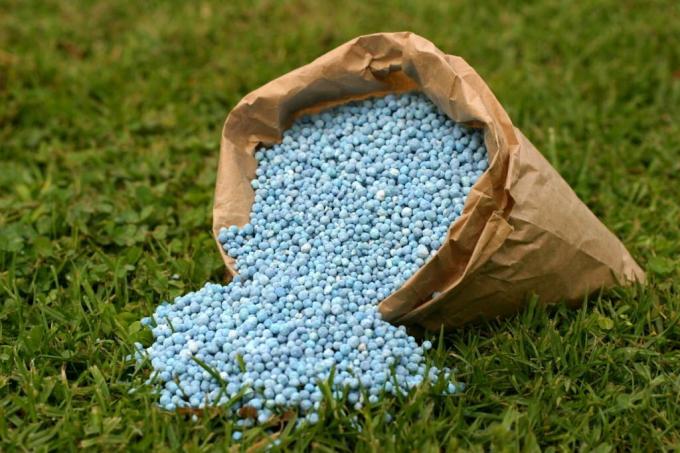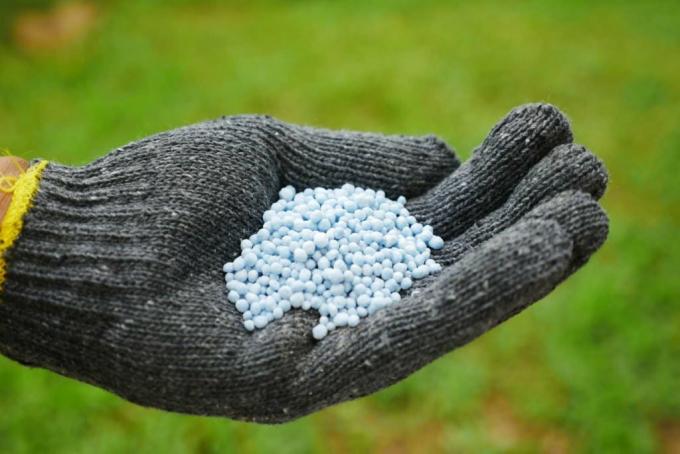Many gardeners like to use the blue grains when fertilizing their lawns. We show you why you should keep your hands off blue grain when fertilizing your lawn.

Blaukorn was originally developed by Compo Expert, but has since been copied in many ways. We explain here whether the properties of blue grain also make it a suitable fertilizer for your lawn.
contents
- Fertilizing lawns with blue grain: effect and application
- Disadvantages of blue grain
- Alternatives to blue grain as lawn fertilizer
In the following, we will explain the effects and use of blue grain to you, then we will name the most important disadvantages. We always assume the original product and not possible copies of other brands. Finally, we would like to point out good alternatives for blue grain that supply your lawn in a natural way.
Fertilizing lawns with blue grain: effect and application
Blue grain is a well-known mineral universal fertilizer with the composition 12 - 8 - 16 - 3 - 10, this one Specification stands for 12% nitrogen, 8% phosphorus oxide, 16% potassium oxide, 3% magnesium oxide and 10% Sulfur. It also contains the trace elements boron, iron and zinc. In the case of special special series - for example "Blaukorn Premium" - the composition can be different. Copies from other manufacturers are also composed differently and only benefit from the prominence of the blue beads. More information about mineral fertilizers in general, see this special article.

How does blue grain affect the lawn?
Blue grain fertilizer is designed in such a way that it disintegrates particularly quickly when it comes into contact with water. Its ingredients are very easily soluble and should therefore be available to plants within a very short time. According to the manufacturer, it is suitable for soils with demonstrably low to medium phosphorus and potash contents. The nitrification inhibitor DMPP is also partially contained, but we can only say this with certainty about the original blue grain fertilizers from Compo Expert. The application should always be carried out according to the manufacturer's instructions, which can be queried on the associated website in case of doubt. The application period is also strictly limited to the main vegetation season (mid-March to September).
Tip: The use of nitrification inhibitors inhibits the activity of Nitrosomona bacteria. These ensure the oxidation of ammonium to nitrate in the soil. Nitrate is well suited for uptake by plants, but it is extremely easily washed out and should therefore never be in the soil in too large unused quantities. In the case of strong nitrification, there is also increased outgassing of nitrogen oxides (NOX), which are harmful to health and the climate. So nitrification inhibitors help to use nitrogen more efficiently and to avoid environmental damage.

Disadvantages of blue grain
Blue grain fertilizer is a purely mineral universal fertilizer with a quick effect. What initially sounds quite positive, however, turns out to be a problem on closer inspection:
- Mineral fertilizers bypass the natural decomposition process of the soil, do not provide beneficial soil organisms with food and thus impoverish the soil fauna. Not just the familiar ones worms, also other little helpers who take part in the making available of nutrients, the water supply of the Plants and are sometimes even involved in the defense against diseases, one reduces in their number.
- A few types of bacteria are motivated by large amounts of readily available nitrogen to break down organic matter contained in the soil. However, if new material is not brought in at the same time, they begin to break down humus. What special properties humus and why you should encourage it rather than reduce it, you can read here.
- The rapid availability can lead to over-fertilization if used incorrectly. Everything for Overfertilization of lawns You will find here.

Tip: Have you caused fertilizer damage by mineral fertilizers or has a dog peed a hole in the lawn with its nitrogen-containing urine? Here you can find out everything about Repair of lawn with the right lawn paving. the Plantura lawn repair is ideally suited for this, for example.
- If used incorrectly, the rapid availability can also lead to nitrate leaching into the groundwater and to the Outgassing of nitrogen oxides into the atmosphere as soon as the nitrification inhibitor takes effect after four to ten weeks subsides.
- Universal fertilizer - like ours for example Plantura organic universal fertilizer - should cover a wide range of different plants. However, the high phosphorus and potassium levels will not be necessary for most plants. Lawn grasses benefit from potassium, which is involved in the water balance and cell wall structure, but the amount contained in blue grain by far exceeds the requirement. Phosphorus is also present in sufficient quantities in a great many garden soils and, in the event of a large excess, can be washed into sensitive ecosystems through erosion. The trace elements it contains should only be fertilized if there is actually a deficiency, as plants only need them in very small quantities. From an economic point of view, too, the use of blue grain for lawn fertilization does not make sense.
- The immediate availability of nitrogen can lead to sudden growth in lawns. The resulting stalks are often not adequately protected against frost, heat and fungal infections due to the excess nitrogen.
Tip: Grasses that are too well supplied with nitrogen can be more easily surprised by frost in winter. Then, above all, the sensitive one becomes German ryegrass (Lolium perenne) attacked by frost - one then speaks of a "wintering" of the lawn. In this case, you should use a Turf overseeding integrate it back into the lawn. Otherwise the area appears light and is not very competitive with weeds. With the Plantura lawn reseeding for example, your lawn will soon be bright green again.
- Mineral fertilizer is produced industrially or extracted from fossil deposits. Especially the phosphorus deposits are limited and their degradation is actually an unnecessary burden on the Environment: There is far enough phosphorus in many organic materials to fertilize plants contain.
Alternatives to blue grain as lawn fertilizer
Only supplying your lawn - or plants in general - with mineral nutrients that plants absorb and use is very brief. Fertilizing should also be about caring for the soil under the plants and maintaining its quality. Because the soil is more than just some dirt in which the roots are clinging: it is rather sensitive, complex and very Efficient system This system has to feed plants, store water, fix carbon dioxide and many more on a daily basis Perform tasks.
For this reason, we primarily recommend organic lawn fertilizers with an organic certificate for lawn fertilization. These act not only as plant fertilizers, but also as soil fertilizers. Microorganisms are promoted and the humus content is stabilized or even increased. Over-fertilization and leaching are as good as impossible and the natural long-term effect ensures even and healthy growth. As a result, lawn grasses are better prepared for adversities - such as fungal infections, heat and drought stress or frost. So we have ours Plantura organic lawn fertilizer and ours Plantura organic autumn lawn fertilizer designed so that you can protect your soil and your plants alike. The Plantura organic soil activator.

More information on the topic Lawn fertilizer as well as an overview of the different types of lawn fertilizer can be found here in our article.
